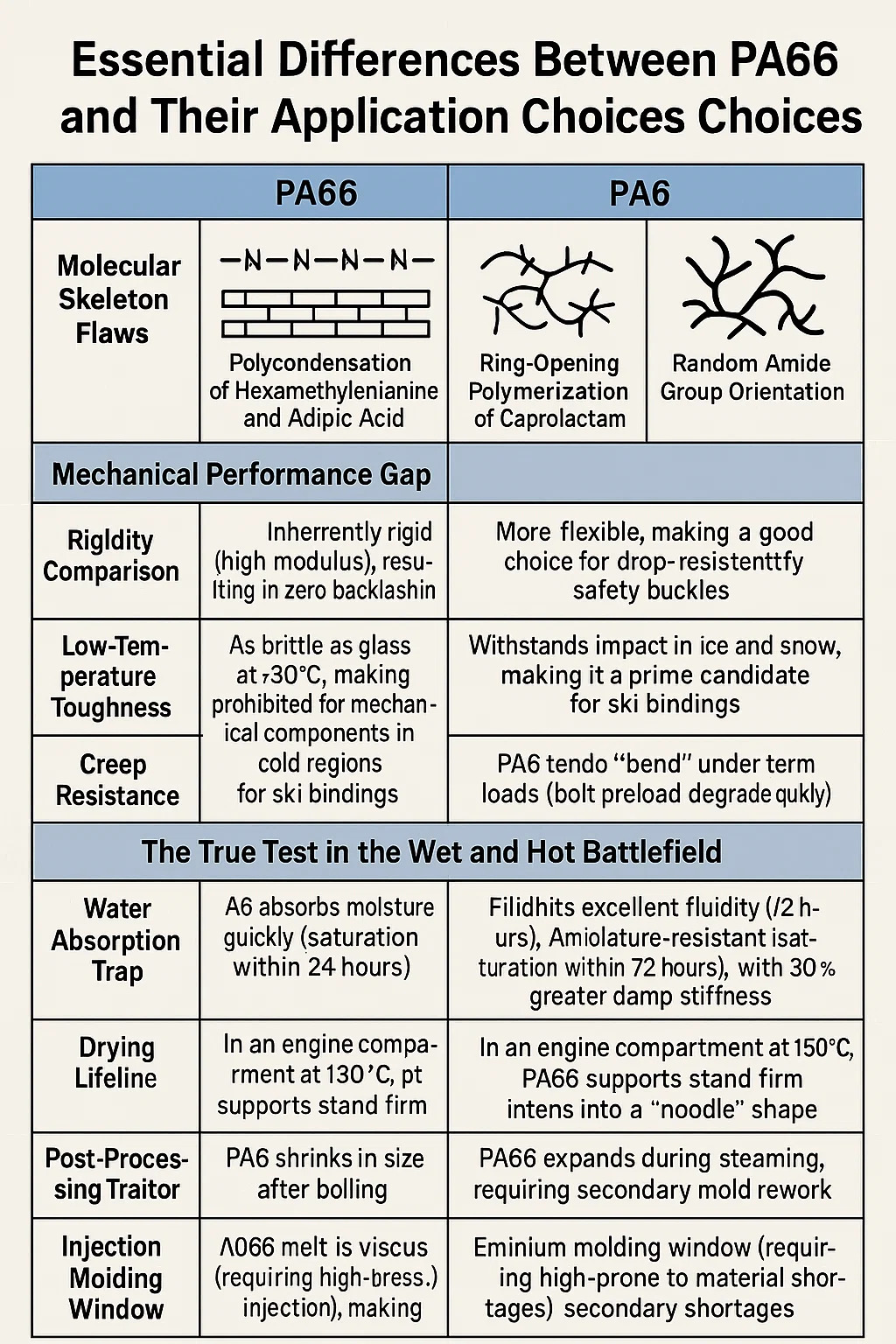
Essential Differences Between PA66 and PA6 and Their Application Choices
1. Molecular Skeleton Flaws
PA66: Polycondensation of Hexamethylenediamine and Adipic Acid → Symmetrical Arrangement of Amide Groups, Dense Hydrogen Bonding Network, and Stacked Molecular Chains Like a Brick Wall
PA6: Ring-Opening Polymerization of Caprolactam → Random Amide Group Orientation, Locally Loose Hydrogen Bonds, and Molecular Chains Resembling Intertwined Branches
2. Mechanical Performance Gap
Rigidity Comparison: PA66 is inherently rigid (high modulus), resulting in zero backlash in gear meshing; PA6 is more than flexible, making it a good choice for drop-resistant safety buckles.
Low-Temperature Toughness: PA66 is as brittle as glass at -30°C, making it prohibited for mechanical components in cold regions; PA6 withstands impact even in ice and snow, making it a prime candidate for ski bindings.
Creep Resistance: PA66 gearboxes retain their shape after ten years of engagement; PA6 tends to "bend" under long-term loads (bolt preload degrades quickly).
3. The True Test in the Wet and Hot Battlefield
Water Absorption Trap: PA6 absorbs moisture quickly (saturation within 24 hours), resulting in a 3% dimensional increase after boiling; PA66 is moisture-resistant (saturation within 72 hours), with 30% greater damp stiffness.
High-Temperature Collapse: In an engine compartment at 130°C, PA66 supports stand firm; PA6 softens into a "noodle" shape.
4. Processing Hidden Challenges
Injection Molding Window: PA66 melt is viscous (requiring high-pressure injection), making thin-walled parts prone to material shortages; PA6 exhibits excellent fluidity (easily molding 0.3mm precision teeth).
Drying Lifeline: PA66 moisture content > 0.15% → barrel splashing bubbles; PA6 moisture content > 0.2% → only surface silver streaks.
Post-Processing Traitor: PA6 shrinks in size after boiling (internal stress release); PA66 expands during steaming, requiring secondary mold rework. V. Life-or-Death Selection Field
Life-threatening Scenarios, Life-saving Materials, Sudden Death Risk
Automotive Turbine Pipe (130°C Oil and Gas) PA66 PA6 Softening and Leakage → Engine Detonation
Mountaineering Crampons (-40°C Impact) PA6 PA66 Low-Temperature Brittle Fracture → Cliff Fall
Hydraulic Valve Block (24/7 Pulsation) ️ PA66 PA6 Creep Pressure Relief → 10,000-Ten Thousand-Ten Thousand-Ten Thousand-Yuan Press Loss of Control
Ocean Buoy (Salt Spray + Sunlight) PA6 PA66 Intergranular Corrosion → Ineffective Shipwreck Marker
5. Unspoken Rules of the Underworld
| Life-or-Death Scenario | Material to Survive | Critical Failure Risk |
|---|---|---|
| Auto Turbo Pipes(130°C oil/gas) | ️ PA66 | PA6 softens → oil leaks → engine fire |
| Mountain Climbing Crampons(-40°C impact) | PA6 | PA66 brittle fracture → falls |
| Hydraulic Valve Blocks(24/7 pulsation) | PA66 | PA6 creep deformation → 10,000-ton press runaway |
| Marine Buoys(salt spray + UV) | PA6 | PA66 crystalline corrosion → buoy sinks |




 English
English 中文简体
中文简体 Español
Español русский
русский






